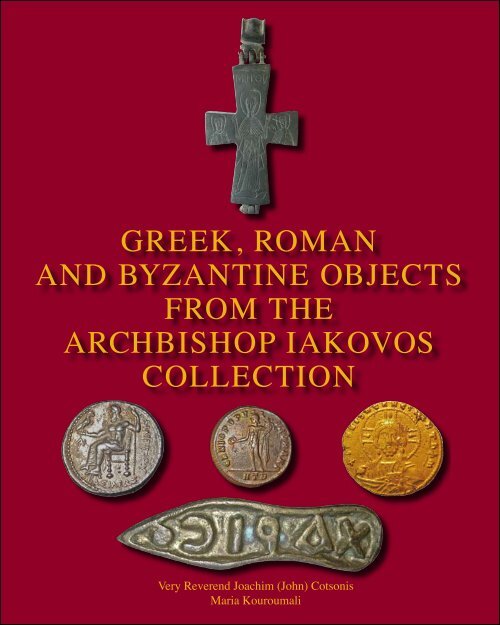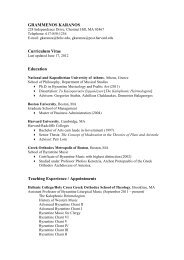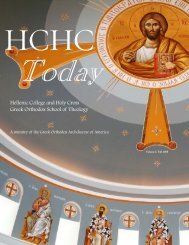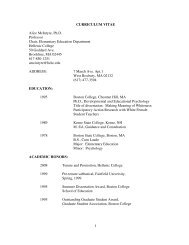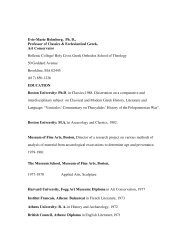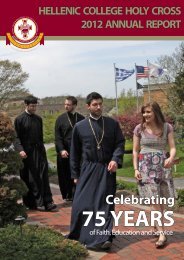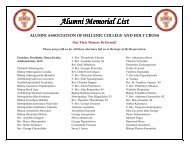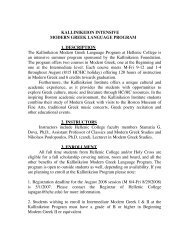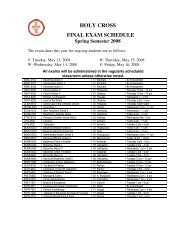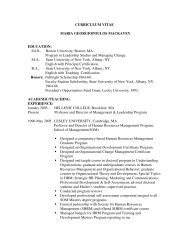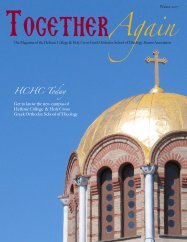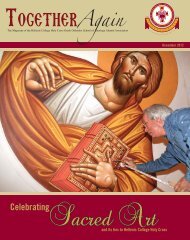GREEK, ROMAN AND BYZANTINE OBJECTS ... - Hellenic College
GREEK, ROMAN AND BYZANTINE OBJECTS ... - Hellenic College
GREEK, ROMAN AND BYZANTINE OBJECTS ... - Hellenic College
Create successful ePaper yourself
Turn your PDF publications into a flip-book with our unique Google optimized e-Paper software.
<strong>GREEK</strong>, <strong>ROMAN</strong><br />
<strong>AND</strong> <strong>BYZANTINE</strong> <strong>OBJECTS</strong><br />
FROM THE<br />
ARCHBISHOP IAKOVOS<br />
COLLECTION<br />
Very Reverend Joachim (John) Cotsonis<br />
Maria Kouroumali
His Eminence Archbishop Iakovos<br />
Primate of the Greek Orthodox Archdiocese of North & South America (1959-1996)<br />
(b. 1911, d. 2005)<br />
This publication was produced by the generous support of<br />
The Mary Jaharis Center for Byzantine Art & Culture<br />
This publication uses the fonts Athena Ruby, Coin Inscription and Grierson, courtesy Dumbarton Oaks, Trustees for<br />
Harvard University, Washington, D.C. and Cypriot, courtesy of Lawrence K. Lo, Ancient Scripts, San Francisco, CA<br />
t<br />
q<br />
HELLENIC COLLEGE<br />
HOLY CROSS <strong>GREEK</strong> ORTHODOX SCHOOL OF THEOLOGY<br />
<br />
1937 2012<br />
<br />
© 2012 Very Rev. Joachim (John) Cotsonis, Maria Kouroumali<br />
<br />
<br />
s<br />
1937<br />
<br />
s
Contents Page<br />
Introduction and Acknowledgements 2<br />
1. Bronze Bread Stamps 3 - 5<br />
2. Bronze Reliquary Cross-Pendants 6 - 7<br />
3. Greek, Roman and Byzantine Coins<br />
3.I - Greek Coins 8 - 11<br />
3.II - Roman Coins 12 - 16<br />
3.III - Byzantine Coins 17 - 26<br />
3.IV - Uncertain Identification of Greek, 27 - 29<br />
Roman and Byzantine Coins<br />
4. Bibliography and Further Reading<br />
Bread Stamps 30<br />
Reliquary Cross-Pendants 30 -31<br />
Greek, Roman and Byzantine Coins 31 - 33<br />
1
2<br />
Introduction and Acknowledgments<br />
The Archbishop Iakovos Collection is found on the top floor of the library named<br />
for this distinguished, late hierarch. The Collection, acquired as either gifts or<br />
purchases during His Eminence’s lifetime (1911-2005), primarily consists of<br />
vestments, liturgical artifacts, commemorative gifts, awards and memorabilia<br />
reflecting the Archbishop’s long and celebrated ministry as the leading hierarch<br />
of the Greek Orthodox Church of North and South America (1959-1996). These<br />
items have been on display since 1999 when the library was formally dedicated,<br />
with Archbishop Iakovos and other dignitaries in attendance. Most of the objects<br />
within this Collection belong to the post-Byzantine and modern periods. More<br />
recently, a number of classical and Byzantine pieces that had belonged to<br />
Archbishop Iakovos were transferred to the Collection. These consist of Greek,<br />
Roman and Byzantine coins, numbering 42 specimens, as well as three Byzantine<br />
bronze bread stamps and two Byzantine bronze, reliquary cross-pendants.<br />
We are grateful to the Trustees of the Archbishop Iakovos Museum,<br />
especially His Grace, Bishop Andonios of Phasiane, for permission to examine<br />
and catalog these objects and to reproduce the images; our colleagues on the<br />
Board of the Mary Jaharis Center for Byzantine Art and Culture for their support<br />
of the project; Dr. Joel Kalvesmaki, Editor in Byzantine Studies at Dumbarton<br />
Oaks, for advice on the use of the Athena Ruby and Grierson fonts; Meredyth<br />
Houpos, for her assistance in the use of the ancient Cypriot font; Professor<br />
Carmen Arnold-Biucchi, Damarete Curator of Ancient Coins at the Harvard Art<br />
Museum, for her invaluable help with the chronological placement of several<br />
worn coin specimens; Garrick Manninen for creating the coin installation; and<br />
Robert Segal for the exhibition design, installation and the catalogue production.<br />
Through the generous support of the Mary Jaharis Center for Byzantine<br />
Art and Culture, funding was provided to carry out the research necessary for<br />
the identification of all the pieces and for their installation and display. The<br />
Greek, Roman and Byzantine objects are exhibited for the first time during the<br />
thirty-eighth annual Byzantine Studies Conference, November 1- 4, 2012, and<br />
will remain on display as part of the permanent Archbishop Iakovos Collection.<br />
October 2012<br />
Brookline, MA<br />
Very Rev. Joachim (John) Cotsonis<br />
Maria Kouroumali
1. Bronze Bread Stamps<br />
Among pre-Christian Mediterranean cultures ceremonial breads were used for<br />
festivals devoted to pagan deities. These breads could be offered to the divinity that<br />
was being honored or to the worshippers as a sacred gift from the gods. Prominent<br />
among these ancient festivals was that devoted to Asklepios, the god of health,<br />
where ceremonial bread, referred to as ὑγεíα (hygεια, or health), was distributed to<br />
the participants for the curing of illnesses or the protection against sickness. These<br />
breads were usually stamped with various symbols or with the single word “hygeia.”<br />
With the establishment of Christianity, the use of ceremonial breads<br />
continued, most importantly for the elements of the Eucharistic liturgy. The bread of<br />
the Christian oblation was also stamped with various symbols. In the early centuries<br />
the Eucharistic bread was usually given the seal of the Christogram or a simple<br />
cross. Other stamps marked the Eucharistic bread with such words as (Phos-<br />
“Light”), (Zoe-“Life”) or (Hygeia-“Health”). By the middle Byzantine<br />
period, it became customary to stamp the center of the Eucharistic bread with the<br />
marks of a central cross and within the quadrants of the cross-arms to have the<br />
letters IC XC NI KA (Jesus Christ Conquers), as is the current liturgical practice of<br />
the Orthodox Church.<br />
In addition to the Eucharistic rites, bread was used in connection with other<br />
ecclesiastical ceremonies in the early Christian and Byzantine periods. Blessed bread<br />
was given to those not receiving Communion (later to be known as the antidoroninstead<br />
of the Holy Gifts, as in the modern practice), or distributed to the faithful on<br />
the celebrations of saints’ days, great feasts of the liturgical year, or at pilgrimage<br />
sites. On such occasions bread would also be distributed to the poor. In addition,<br />
bread was given out at memorials for the dead. In general these special breads were<br />
known as eulogia breads (or blessings) and would also be stamped with either<br />
images of saints or benedictional invocations such as “health,” “life,” or “joy.”<br />
The majority of surviving early stamping instruments is bronze, although a<br />
smaller number of examples of stone, terracotta or wood are known. The stamps<br />
take on a variety of shapes: rectangular, square, triangular, circular or even slippershaped.<br />
Their texts are commonly short invocations or single words indicating some<br />
spiritual or physical blessing intended for the recipient. Usually the text of the stamp<br />
is carved in reverse so that the impression will read from left to right; however, there<br />
are a number of surviving stamps that were not carved in reverse so that the<br />
resulting seal appears backward.<br />
3
4<br />
1. Bronze Bread Stamp<br />
Eastern Mediterranean, possibly Asia Minor<br />
5th-7th century<br />
4.5 cm x 10.2 cm; 200 gm<br />
INSCRIBED: /(Christ, help)<br />
not in reverse<br />
2. Bronze Slipper-Shaped Bread Stamp<br />
Eastern Mediterranean, possibly Asia Minor<br />
5th-7th century<br />
2.8 cm (maximum) x 10.8 cm; 139 gm<br />
INSCRIBED: ● ( in reverse)<br />
(Grace)
3. Bronze Slipper-Shaped Bread Stamp<br />
Eastern Mediterranean, possibly Asia Minor<br />
5th-7th century<br />
2.6 cm (maximum) x 10.5 cm; 137 gm<br />
INSCRIBED: ● ( in reverse)<br />
(Grace)<br />
5
6<br />
2. Bronze Reliquary Cross-Pendants<br />
The cross-shaped pendants, or engolpia, derive from early Christian metal crosses<br />
that were worn around the necks of believers and often had small openings to<br />
enclose fragments of the True Cross, some other relic, or various blessed objects.<br />
The majority of these early crosses, however, were not meant to be reliquaries.<br />
These early crosses bore either decorative patterns or some image of the crucified<br />
Christ or other holy figures. After the first Iconophile victory of 787, the role of<br />
personal, historiated phylacteries, or cross-pendants, took on a great significance<br />
among the supporters of holy images as a visual expression of their Orthodoxy,<br />
especially high-ranking individuals such as Patriarch Nikephoros I (806-815).<br />
These phylacteries usually bore an image of the crucified Christ, the Virgin,<br />
saints or images from the life of Christ. They were constructed in halves and<br />
joined by a hinge and locking device so that they could be opened to insert either<br />
a fragment of the True Cross, some other sacred relic, or blessed object. They<br />
were worn as an amulet whereby the owner expressed not only their support of<br />
holy images but also their belief in the protective powers of the sign of the Cross<br />
and relics, all sacred objects supported by the Iconophiles.<br />
Historiated reliquary cross-pendants were produced in various precious<br />
metals such as the following ninth-century examples: gold (the Pliska cross, in<br />
Sofia), silver (the Vicopisano cross, in Pisa) and enamel work (the Beresford-<br />
Hope cross, in London). But the historiated reliquary cross-pendant was also<br />
mass-produced in bronze in workshops throughout the Byzantine Empire from<br />
the ninth to the twelfth century. Hundreds of these more modest examples<br />
survive and are found in many museum and private collections. Their large<br />
number give evidence to the popular piety which stimulated the production of<br />
these bronze reliquary crosses and their owners’ trust in the efficacy of the<br />
protective and healing powers of the Cross, images of Christ and the saints, and<br />
holy relics in the post-Iconoclastic centuries
4. Bronze Pectoral Reliquary Cross<br />
Byzantine (Constantinople or Anatolia)<br />
11th century<br />
10.7 cm (with suspension) X 5 cm x 0.6 cm<br />
56 gm<br />
Obverse<br />
INSCRIBED: (Peter)<br />
Saint Peter orans standing<br />
Reverse<br />
Glass paste at center, decorative pattern of<br />
crossing lines and knot motif<br />
5. Bronze Pectoral Reliquary Cross<br />
Byzantine (Constantinople or Anatolia)<br />
10th-11th century,<br />
10.3 cm (with suspension) x 4.7 cm x 1.2 cm<br />
89 gm<br />
Obverse<br />
INSCRIBED: (Jesus Christ conquers)<br />
Crucifixion, Christ wearing the long kolobion<br />
Reverse<br />
INSCRIBED: (Mother<br />
of God)<br />
Virgin orans standing, flanked by busts of<br />
two unidentified bearded saints holding<br />
Gospel books<br />
7
8<br />
3. Greek, Roman and Byzantine Coins<br />
Coins were first introduced for commercial and trade purposes. The coin was a<br />
valuable, durable, mobile object which also made it an ideal vehicle for the<br />
dissemination of political messages, a function that it has preserved to the<br />
present day.<br />
3.I Greek Coin<br />
Surveys of the history of coinage begin with the introduction of coins into the<br />
ancient Greek world some time around 700 BC on the island of Aegina, or<br />
according to others, in 650 BC in Ephesus of Lydia, presumably because trading<br />
networks required an easier and lighter mode of exchange than the previous<br />
barter system in kind. As with most types of Greek art, we can distinguish three<br />
periods in the production and design of coins: the Archaic (ca. 700 - 480 BC); the<br />
Classical (ca. 480-330 BC) and the Hellenistic (ca. 330 BC to the Roman conquest<br />
of the Greek world in the first century). The coins produced by Greek cities<br />
under Roman rule are known as Roman provincial coins or Greek imperial coins.<br />
The first coins were made of electrum, a gold-silver alloy. Later,<br />
technological advances made the production of pure gold or pure silver coins<br />
alongside bronze and copper alloy coins. Coins were hand-made and not<br />
machine-produced as in the modern period. The central denomination of the<br />
ancient Greek world was the drachm(a), which translated literally means 'a<br />
handful.' The drachm was divided into six obols (lit., 'spit of iron') and the obol<br />
was further divided into the tetartemorion (1/4 of an obol and 1/24 of a drachm) and<br />
multiple divisions of it. Other common denominations were multiples of the<br />
drachm, such as the silver stater or didrachm (two drachmae), the tetradrachm (four<br />
drachmae) and, particularly in Syracuse, the large silver decadrachm (ten drachmae).<br />
Several hundred of the approximately 1500 self-governing city-states<br />
(poleis) issued their own coins although only a few circulated widely beyond<br />
their city-state, such as the silver staters of Aegina and Athens; the Athenian<br />
tetradrachm (4.3 grams of silver to a drachm) eventually became the primary<br />
trading coin throughout the classical period and set the standard for the coin<br />
issues of other city-states.<br />
The main design features of ancient coins were portraits of the city-state's<br />
patron god or goddess or those of a legendary hero on the one side of the coins<br />
and symbols of the city-state on the other (e.g., turtle and later tortoise for<br />
Aegina; the owl of Athena for Athens; the head of the nymph Arethusa and a<br />
victorious quadriga for Syracuse). The inscriptions usually were the name of the<br />
issuing city-state. The peak of technical quality and aesthetic detail was reached
during the Classical period with a range of very fine silver and gold coins,<br />
including exquisite specimens from the wealthy tyrants of Syracuse.<br />
The use of portraits of living individuals, i.e., the kings themselves, began<br />
in the Hellenistic period. Long-avoided by most of the other Greeks as a sign of<br />
arrogance, the Ptolemaic and Seleucid kings, being of 'divine' status, issued gold<br />
coins with their own portraits with symbols of their kingdoms on the reverse<br />
side. The names of the kings were usually inscribed on the coins as well, thus<br />
setting the standard pattern for coins, which has reached the modern world with<br />
variations.<br />
9
10<br />
Greek Coins<br />
Roman Coins<br />
Byzantine Coins<br />
Uncertain Coins<br />
6. Silver Stater of Evagoras I<br />
Cyprus (Salamis), 411-373 BC<br />
Obverse<br />
DIAM: 6 mm; 2.96 gm<br />
INSCRIBED: (Cypriot syllabary<br />
for Evagoras)<br />
Herakles seated on a rock with lion’s skin,<br />
facing right, in left hand holds rhyton,<br />
in right holds club<br />
Reverse<br />
DIAM: 6mm; 2.96 gm<br />
INSCIBED: ; in exergue-<br />
(Cypriot Syllabary for King Ev[agoras])<br />
Recumbent ram, facing right<br />
7. Silver Stater<br />
Akarnania, Anaktorion? (4th C BC)<br />
Obverse<br />
DIAM: 19mm; 8.56 gm<br />
INSCRIBED: Below Pegasus, <br />
Pegasus with pointed wing, flying left<br />
Reverse<br />
INSCRIBED: On right, <br />
Head of Athena, facing left, wearing,<br />
over leather cap, Corinthian helmet<br />
with no crest<br />
Behind head, omphalos<br />
<br />
8. Silver Stater<br />
Aegina (5th-4th C BC)<br />
Obverse<br />
DIAM: 23mm; 9.52 gm<br />
INSCRIBED: On left, <br />
Tortoise with segmented shell<br />
Reverse<br />
INSCRIBED: Large incuse square<br />
with thin skew pattern<br />
and in upper incuses,<br />
dolphin upward in lower left incuse
9. Silver Tetradrachm of Philip III Arrhidaeus<br />
323-317 BC<br />
Obverse<br />
DIAM: 24 mm; 17.16 gm<br />
Head of young Herakles in lion’s skin,<br />
facing right<br />
Reverse<br />
DIAM: 24 mm; 17.16 gm<br />
INSCRIBED: ΦΙΛΙΠΠΟΥ ΒΑΣΙΛΕΩΣ<br />
(of Philip the King)<br />
Monogram in left field, Zeus enthroned,<br />
facing left, in right hand holds eagle;<br />
in left hand holds scepter<br />
10. Silver Tetradrachm of Seleucus I Nikator<br />
Seleucia on the Tigris (ca. 295-281 BC)<br />
Obverse<br />
DIAM: 25mm; 17.01 gm<br />
Head of young Herakles facing right<br />
in lion’s skin<br />
Reverse<br />
DIAM: 23mm; 17.01 gm<br />
INSCRIBED: ΣΕΛΕΥΚΟΥ ΒΑΣΙΛΕΩΣ<br />
(of Seleukos the King)<br />
Below throne ΔΙΟ (Zeus)<br />
Zeus enthroned, facing left, holding eagle<br />
on extended right hand and scepter in left;<br />
below left: crescent and monogram within<br />
shield<br />
<br />
11. Silver Drachm Coin-Pendant<br />
Sinope (ca. early 5th to 4th C BC)<br />
Obverse<br />
DIAM: 18mm; 5.81 gm<br />
Head of Nymph Sinope facing left;<br />
far left, aplustre<br />
Reverse<br />
INSCRIBED: CIΝΩ<br />
Sea eagle standing on dolphin;<br />
on upper right sideways ?<br />
<br />
11
12<br />
3.II Roman Coins<br />
Coins were introduced by the Roman Republic relatively late, around 300 BC,<br />
compared to their Greek neighbors in the East. The Greek colonies in Italy (such<br />
as Naples, Taranto, Heraclea, Croton, Thurii) had already been using coins for<br />
most of the previous three centuries. Scholars have argued that the adoption of<br />
coinage by the Romans was based on cultural considerations and arose out of a<br />
need to adopt a Greek institution during a time when the Roman world was<br />
becoming increasingly influenced by <strong>Hellenic</strong> culture. The earliest type of Roman<br />
coinage were large bronze bars, weighing more than 1,500 grams and known as<br />
aes signatum ('struck bronze'). Alongside these, the Romans issued silver and<br />
bronze coins similar in style and design to those of the southern Italian Greek<br />
colonies.<br />
The main denominations until the middle of the third century were the<br />
aureus (gold), the denarius (silver), the sestertius and dupondius (both brass) and<br />
the as (copper). In the third century, the denarius was replaced by the antoninianus<br />
or radiate (double denarius) which was replaced towards the end of the third<br />
century by the argenteus (silver) and the follis (silvered bronze), introduced<br />
during the monetary reforms of Diocletian. After Diocletian's reforms and until<br />
the end of the Empire in the West, Roman coins were mainly the gold solidus<br />
(continued in the early and middle Byzantine period) and small bronze<br />
denominations.<br />
The early Republican circular coins were decorated with personifications<br />
of the city of Rome and various gods and goddesses driving a biga or quadriga<br />
(two-horse and four-horse chariot respectively). The role of deciding which<br />
images were used on coins belonged to a committee of three young statesmen<br />
with aspirations to the senatorial rank known as the tresviri monetales ('trio of<br />
money-men', an institution that began in 298 BC and lasted until the middle of<br />
the third century. Julius Caesar increased the number of the committee from<br />
three to four. Initially, there was no mention of the names of the money-men on<br />
the coins. Later the small symbols, letters or monograms were replaced with<br />
abbreviated forms of the money-men's names. Some of the appointees to this<br />
institution eventually began using the coins to display images related to their<br />
family history. This self-promoting imagery was part of the ever-increasing<br />
competition amongst the Roman ruling elite. A significant change in design was<br />
made when Julius Caesar became the first Roman to issue coins bearing his own<br />
portrait rather than those of family ancestors or symbols.
This tradition continued with the imperators (emperors), although<br />
emperors also issued coins that featured some of the traditional deities and<br />
personifications found on earlier coins. The portrait of the emperor became the<br />
focal point of imagery during the Early Empire and the Later Roman period as<br />
coins were a convenient means to disseminate the image throughout the vast<br />
empire. The emperor was often associated with divine attributes or pictured with<br />
particular deities, emphasizing the special relationship between them. The<br />
majority of obverse images have portraits of the emperor but other portraits were<br />
also used such as the heirs apparent, predecessors and other family members,<br />
such as empresses. In order to aid the claims of succession, the legitimacy of an<br />
heir was indicated by issuing coins in his name, a practice that began under<br />
Augustus and continued until the end of the Byzantine period. The portraits<br />
were usually stylized and lacked originality although generalizations should be<br />
avoided. During especially turbulent times, such as the fraught third century, the<br />
emperors resorted to the more traditional images, perhaps in an attempt to<br />
establish their legitimacy which often was questionable.<br />
Diocletian also introduced a standard imagery on the coins during his<br />
reforms. This consisted of a stern portrait, representative of the emperor in<br />
general, rather than any individual emperor. The reverse was equally abstract,<br />
usually featuring the genius (spirit) of the Roman people personified. It has been<br />
argued that this imagery was an attempt by Diocletian to instill a sense of peace,<br />
stability and traditional values within the Empire following the insecurity and<br />
conflicts of the previous period.<br />
With the adoption of Christianity as the state religion of the Roman<br />
Empire, Christian imagery, such as the Christogram (the Χ Ρ monogram for the<br />
name of Jesus Christ in Greek), was introduced but there were no explicitly<br />
Christian themes with a few notable exceptions.<br />
The original Roman mint network was reorganized and centralized by<br />
Diocletian as part of his monetary reforms. Each provincial diocese had only one<br />
mint, which in the case of large mints, could have several officinae (workshops).<br />
Over the next two centuries, some of these mints were closed and others opened<br />
depending on the fiscal and administrative necessities. Emperors also had mints<br />
attached to their comitatus (retinue) In 366-9, legislation restricted the issuance of<br />
precious metal coins to these imperial retinue mints, either from permanent<br />
bases, or when campaigning, making use of the nearest regional mint to the<br />
imperial retinue. Following the major invasions of the Germanic tribes in the<br />
West during the fifth century, the Roman mint network system collapsed with<br />
13
14<br />
some exceptions of mints used by the Ostrogoths and Burgundians to issue<br />
coins. By the accession of Anastasius I (491-518), the only old Roman mints still<br />
active were in Constantinople and Thessalonica.<br />
Roman coins had a value higher than their precious metal content which<br />
was debased several times until the end of the empire. The exact reasons for the<br />
debasement of Roman coinage are uncertain but lack of raw metal with which to<br />
produce coins (Italy had no large mines itself), inflation, military campaigns,<br />
extended trade outside the Mediterranean world and inadequate state finances<br />
all played a role in this.
12. Silver Didrachm of Hadrian<br />
Cappadocia (Caesarea), 128-138<br />
Obverse<br />
DIAM:19 mm; 6.89 gm<br />
INSCRIBED: <br />
(Hadrian, Sebastos)<br />
Bust of Hadrian facing right, wearing<br />
laurel wreath<br />
Reverse<br />
DIAM. 19 mm; 6.89 gm<br />
INSCRIBED: <br />
(Consul III, Father of the Fatherland)<br />
Hadrian standing atop Mount Argaeus, holding<br />
scepter in left hand, right hand outstretched,<br />
flanked by sun and crescent moon<br />
13. Copper Follis (Nummus) of Diocletian<br />
Roman (Cyzicus), 295 - 99<br />
Obverse<br />
DIAM: 19mm; 3.15 gm<br />
INSCRIBED:<br />
IMPCCVALDIOCLETIANVSPFAVC<br />
(Imperator Caesar Caius Valerius Diocletianus<br />
Pius Felix Augustus)<br />
Radiate crown, draped, cuirassed bust of<br />
Diocletian facing right<br />
Reverse<br />
DIAM: 18mm; 3.15 gm<br />
INSCRIBED: CONCORDIA MILITVM<br />
(Military concord)<br />
Diocletian, standing at left, holding scepter,<br />
receiving Victory on globe from Jupiter,<br />
standing at right, holding scepter<br />
Mintmark in lower center: ΚΓ<br />
<br />
14. Copper Follis (Nummus) of Constantius I Chlorus Caesar<br />
Roman (Heraclea), 293/4-305<br />
Obverse<br />
DIAM: 25mm; 10.86 gm<br />
INSCRIBED: FLVALCONSTANTIVSNOBCAES<br />
(Flavius Valerius Constantius Nobilitas Caesar<br />
Bust of Constantius, facing right, wearing<br />
laurel wreath<br />
Reverse<br />
INSCRIBED: GENIO POPVLI <strong>ROMAN</strong>I<br />
(To the genius [divine nature] of the Roman<br />
people)<br />
Genius standing facing left, holding patera in his<br />
right hand and a cornucopia in the left<br />
In exergue: HTD (Heraclea mintmark)<br />
<br />
Roman Coins<br />
Byzantine Coins<br />
Uncertain Coins<br />
15
16<br />
15. Coper Follis (Nummus) of Constantine I<br />
Roman (Trier), 310-318<br />
Obverse<br />
DIAM: 21 mm; 5.01 gm<br />
INSCRIBED: IMPCONSTANTINVSAVG<br />
(Imperator Constantinus Augustus)<br />
Bust of Constantine with laurel wreath,<br />
facing right<br />
Reverse<br />
DIAM: 21 mm; 5.01 gm<br />
INSCRIBED: SOLIINVICTOCOMITI<br />
(To the Invincible Sun, companion of<br />
the emperor); T, F (Temporum Felicitas-<br />
Happiness of the times); letters in exergue-PTR<br />
Figure of Sol standing, wearing a chlamys over<br />
left shoulder, facing left, right hand raised,<br />
left hand holds globe<br />
16. Copper Follis (Nummus) of Constantine I<br />
Roman, 310-318<br />
Obverse<br />
DIAM: 18 mm; 1.72 gm<br />
INSCRIBED: IMPCONSTANTINVSPFAVG<br />
(Imperator Constantinus Pius Felix Augustus)<br />
Bust of Constantine with laurel wreath,<br />
facingright<br />
Reverse<br />
DIAM: 18 mm; 1.72 gm<br />
INSCRIBED: SOLIINVICTOCOMI[TI]<br />
(To the Invincible Sun, companion<br />
of the emperor); R X; uncertain letters in<br />
exergue. Figure of Sol standing, wearing a<br />
chlamys over left shoulder, facing left, right<br />
hand raised, left hand holds globe
3.III Byzantine Coins<br />
Byzantine coinage, according to numismatists, begins with the monetary reform<br />
of Anastasius I in 498. The two main Late Roman denominations of the gold<br />
solidus and the bronze nummus were the standard. Anastasius introduced new<br />
bronze coins, multiple of the nummus. These were the 40 nummi (also known as<br />
follis), the 20 nummi (half-follis), the 10 nummi and 5 nummi coins. The obverse of<br />
these coins displayed a stylized portrait of the emperor while the reverse<br />
featured the value of the denomination represented according to the Greek<br />
numeral system (M=40, K=20, I=10, E=5). Silver was rarer with the exception of<br />
the Hexagram coin, first issued by Heraclius in 615 and until the end of the<br />
seventh century. This silver coin was succeeded by the miliaresion, originally a<br />
ceremonial coin established by Leo III the Isaurian around 720 and then<br />
standardized from ca. 830 until the late eleventh century when it was<br />
discontinued after being repeatedly debased. The gold solidus or nomisma was the<br />
standard commercial currency until the eleventh century when a continuous<br />
debasement began under successive emperors starting with Romanos Argyros<br />
(1028-1034).<br />
The Byzantine monetary system is characterized by a series of changes<br />
and reforms. In the seventh century, the 40 nummi (follis) became the only bronze<br />
coin that was issued continually. Its size was now significantly smaller than the<br />
sixth century and it continued to decrease in size despite the attempt of Justinian<br />
II to restore it to its previous size. During the early ninth century, a lighter gold<br />
solidus (about three fourths of the normal solidus weight, which was roughly 4.48<br />
grams ) was issued, named tetarteron and the full weight solidus was now called<br />
the histamenon, roughly 4.48. The unpopularity of the tetarteron meant that it was<br />
only issued sporadically over the next century. Light weight solidi, featuring a<br />
star on both obverse and reverse and weighing about 4.25 grams, were also<br />
issued for trade with the Near East.<br />
Under Alexius I Comnenus (1081-1118), the debased solidus was<br />
discontinued and a gold coin of a higher fineness, and slightly smaller than the<br />
solidus, was issued, known as the hyperpyron, weighing 4.45 grams. The electrum<br />
aspron trachy (debased gold) (trachy, the Greek word for 'rough'), the billon aspron<br />
trachy (debased silver) and the copper tetarteron were also introduced alongside<br />
the hyperpyron. Further new issues of coins occurred under Andronicus II and in<br />
1367 when the gold issues were discontinued and a regular silver issue called the<br />
stavraton replaced gold. Byzantine coins became thinner and wider progressively<br />
17
18<br />
from the seventh century onwards until the Late Byzantine gold coins were<br />
wafer-thin, cup-shaped (also known as 'scyphate') and could be bent by hand.<br />
The major coin mints of the Byzantine period varied in number from<br />
fourteen under Justinian I (527-565) to Constantinople alone from the late ninth<br />
century until the late eleventh century when some of the provincial mints began<br />
to reappear. During the following two centuries, many mints were operated,<br />
both by the emperors and autonomous local rulers (Cyprus, Rhodes, Nicaea,<br />
Trebizond). The Constantinople and Trebizond mints survived until the<br />
conquest of the cities by the Turks.<br />
The imagery of the Byzantine coins continued the conventions of the Late<br />
Roman coins. On the obverse was the portrait of the emperor, now facing front,<br />
rather than in profile. On the reverse, various Christian symbols, primarily the<br />
Cross, but also Victory or an angel, which soon merged into one.<br />
The first significant departure from this practice were the gold coins of<br />
Justinian II (685-691 and 705-711), who placed the bust of Christ on the obverse<br />
and a half or full-length portrait of the Emperor on the reverse. The Iconoclast<br />
emperors removed the bust of Christ from their coins but this imagery was<br />
revived again after the end of Iconoclasm in the mid-ninth century and<br />
variations of the figure of Christ on the obverse of the coins became the norm<br />
until the end of the Byzantine Empire.<br />
Byzantine coin design and imagery influenced the style of the early<br />
Islamic coins and those of the first Western kingdoms.
17. Copper Follis of Justin I<br />
Byzantine (Constantinople), 518-527<br />
Obverse<br />
DIAM: 30 mm; 16.67 gm<br />
INSCRIBED: DNIVSTI NVSPPVC<br />
(Dominus Noster Iustinus Perpetuus Augustus)<br />
Bust of Justin I, wearing diadem, cuirass and<br />
paludamentum, in profile to right<br />
Reverse<br />
DIAM: 30 mm; 16.67 gm<br />
INSCRIBED: M, flanked by * & +, surmounted by +,<br />
below M is ; in exergue: [C]ON<br />
18. Copper Follis of Justin I<br />
Byzantine (Nicomedia), 518-527<br />
Obverse<br />
DIAM: 29 mm; 16.47 gm<br />
INSCRIBED: DNIVSTI NV[SPPVC]<br />
(Dominus Noster Iustinus Perpetuus Augustus)<br />
Bust of Justin I, wearing diadem, cuirass and<br />
paludamentum, in profile to right<br />
Reverse<br />
DIAM: 30 mm; 16.46 gm<br />
INSCRIBED: M, flanked by * & *,<br />
surmounted by +, below M is ;<br />
in exergue: NIKM<br />
19. Copper Follis of Justin I<br />
Byzantine (Nicomedia), 518-527<br />
Obverse<br />
DIAM: 27 mm; 14.84 gm<br />
INSCRIBED: DNIVSTI NVSPP[VC]<br />
(Dominus Noster Iustinus Perpetuus Augustus)<br />
Bust of Justin I, wearing diadem, cuirass and<br />
paludamentum, in profile to right;<br />
small cross above head<br />
Reverse<br />
DIAM: 28 mm; 14.84 gm<br />
INSCRIBED: M, flanked by + & +,<br />
surmounted by +, below M is B;<br />
in exergue: NIKM<br />
Byzantine Coins<br />
Uncertain Coins<br />
19
20<br />
20. Copper Follis of Justinian I<br />
Byzantine (Cyzicus), 551/2<br />
Obverse<br />
DIAM: 31mm; 17.93 gm<br />
INSCRIBED: DNIVSTINI NVSPPVC<br />
(Dominus Noster Iustinianus Perpetuus<br />
Augustus)<br />
Bust of Justinian I holding globus cruciger in<br />
right hand, helmeted, wearing cuirass, cross<br />
above the shield, with equestrian device, on<br />
left shoulder<br />
Reverse<br />
DIAM: 31mm; 17.93 gm<br />
INSCRIBED: , surmounted by +<br />
below is , flanked left: ,<br />
flanked right: ,<br />
in exergue: KYZ<br />
<br />
21. Copper Follis of Justinian I<br />
Byzantine (Nicomedia), 540/1<br />
Obverse<br />
DIAM: 38mm; 21.39 gm<br />
INSCRIBED: DNIVSTINI NVSPPVC<br />
(Dominus Noster Iustinianus Perpetuus<br />
Augustus)<br />
Bust of Justinian I holding globus cruciger<br />
in right hand, helmeted, with diadem,<br />
wearing cuirass, cross above the shield,<br />
with equestrian device, on left shoulder<br />
Reverse<br />
DIAM: 38mm; 21.39 gm<br />
INSCRIBED: , surmounted by +<br />
below is , flanked left: ,<br />
flanked right: , in exergue: <br />
<br />
22. Copper Follis of Justinian I<br />
Byzantine (Constantinople), 540-541<br />
Obverse<br />
DIAM: 34 mm; 20. 48 gm<br />
INSCRIBED: DNIVSTINI NVSPPVC<br />
(Dominus Noster Iustinianus Perpetuus<br />
Augustus)<br />
Bust of Justinian I, helmeted, with diadem,<br />
wearing cuirass, holding globus cruciger in<br />
right hand, cross above the shield, with<br />
equestrian device, on left shoulder<br />
Reverse<br />
DIAM.: 35 mm; 20.47 gm<br />
INSCRIBED: M, above-+, below-B,<br />
at left: NNO; at right-X II II;<br />
in exergue: CON
23. Copper Half Follis of Justin II & Sophia<br />
Byzantine (Thessalonica), 577-578<br />
Obverse<br />
DIAM: 15 mm; 5.39 gm<br />
INSCRIBED: [DNIVSTI NVSPPVC]<br />
(Dominus Noster Iustinus Perpetuus Augustus)<br />
Justin II (holding globus cruciger) and Sophia<br />
enthroned<br />
Reverse<br />
DIAM: 16 mm; 5.38 gm<br />
INSCRIBED: K; above- Φ+C, at right-XI II;<br />
at left-NNO, below-<br />
24. Copper Follis of Maurice<br />
Byzantine (Antioch), 591/2<br />
Obverse<br />
DIAM: 28mm; 12.51gm<br />
INSCRIBED: δ<br />
(Dominus Noster Mauricius Noster Perpetuus<br />
Augustus)<br />
Bust of Maurice facing, wearing loros<br />
and crown with cross<br />
In right hand, mappa, in left hand,<br />
eagle-topped scepter<br />
Reverse<br />
DIAM: 27mm; 12.51gm<br />
INSCRIBED: M surmounted by +<br />
Below M, <br />
Flanked left: ; flanked right: X<br />
In exergue: THEUP<br />
<br />
25. Gold Solidus of Phocas<br />
Byzantine (Constantinople), 603<br />
Obverse<br />
DIAM: 19mm; 4.36 gm<br />
INSCRIBED: <br />
(Dominus Noster Phocas Perpetuus Augustus)<br />
Bust of Phocas facing, wearing cuirass,<br />
paludamentum and crown with cross<br />
In right hand globus cruciger<br />
Reverse<br />
DIAM: 18mm; 4.36 gm<br />
INSCRIBED: <br />
(Victoria Augusti, fourth officina)<br />
Angel facing, holding in right hand cross staff,<br />
in left hand globus cruciger<br />
In exergue: CONOB<br />
<br />
21
22<br />
26. Gold Solidus of Heraclius and<br />
Heraclius Constantine<br />
Byzantine (Constantinople), 616-625<br />
Obverse<br />
DIAM: 18mm; 4.44 gm<br />
INSCRIBED: [ddNNh]<br />
<br />
(Domini Nostri Heraclius et Heraclius<br />
Constantinus Perpetui Augusti)<br />
To left, bust of Heraclius facing, wearing<br />
chlamys and crown with cross; to right,<br />
small bust of Heraclius Constantine,<br />
beardless, wearing chlamys and crown with<br />
cross; above, small cross.<br />
Reverse<br />
DIAM: 18mm; 4.44 gm<br />
INSCRIBED: [V]ICTORIA <br />
(Victoria Augusti, fifth officina)<br />
In right field (next to cross), I pellet<br />
Cross potent on base and three steps<br />
In exergue: CONOB<br />
<br />
27. Copper Half Follis of Theophilus<br />
Byzantine, 830/31-842<br />
Obverse<br />
DIAM: 20 mm; 3.75 gm<br />
INSCRIBED: <br />
(Theophilus, King [Emperor])<br />
Three-quarter length image of Theophilus,<br />
wearing loros and tufa, right hand holds<br />
labarum, left hand holds globus cruciger<br />
Reverse<br />
DIAM: 20 mm; 3.75 gm<br />
INSCRIBED: ]/[]//<br />
<br />
(Theophilus Augustus, you conquer)<br />
28. Silver Miliaresion of Basil I<br />
Byzantine (Constantinople), 868-879<br />
Obverse<br />
DIAM: 22 mm; 2.83 gm<br />
INSCRIBED: /// <br />
//<br />
(Basil and Constantine Faithful<br />
Emperors of the Romans); triple-row<br />
dot border<br />
Reverse<br />
DIAM: 21 mm; 2.83 gm<br />
INSCRIBE: <br />
(Jesus Christ conquers)<br />
Cross potent on three steps with globus<br />
beneath, triple-row dot border
29. Copper Half Follis of Leo VI<br />
Byzantine (Constantinople), 886-912<br />
Obverse<br />
DIAM: 24mm; 4.85 gm<br />
INSCRIBED: +<br />
(Leo, Emperor of the Romans)<br />
Bust of Leo with short beard facing,<br />
wearing chlamys and crown with cross<br />
On his right shoulder, roundel with<br />
central pellet, in left hand, akakia<br />
Reverse<br />
DIAM: 23mm; 4.85 gm<br />
INSCRIBED: ///<br />
<br />
(Leo, in God, Emperor of the Romans)<br />
<br />
30. Gold Histamenon of Basil II and Constantine<br />
Byzantine (Constantinople), 977-989<br />
Obverse<br />
DIAM: 19mm; 4.09 gm<br />
INSCRIBED: + <br />
(Jesus Christ, King of Those Who Rule)<br />
Bust of Christ facing<br />
His right hand raised in blessing,<br />
in His left, clasps Gospel book<br />
Reverse<br />
DIAM: 18mm; 4.09gm<br />
INSCRIBED: +<br />
(Basil and Constantine, Emperors of the<br />
Romans)<br />
Two busts facing, Basil to left, bearded,<br />
wearing modified loros and crown with<br />
cross, Constantine to right, beardless,<br />
wearing chlamys and crown with cross,<br />
holding between them a patriarchal cross<br />
<br />
31. Copper Anonymous Follis<br />
Byzantine, c. 1030/35-1042<br />
Obverse<br />
DIAM: 23 mm; 10.48 gm<br />
INSCRIBED: IC XC; +[] []<br />
(Jesus Christ; + Emmanuel)<br />
Bust of Christ Emmanuel, right hand blessing,<br />
left hand holding Gospels<br />
Reverse<br />
DIAM: 24 mm; 10.48 gm<br />
INSCRIBED: //<br />
(Jesus Christ, King of Those Who Rule)<br />
Letters of inscription flank Cross on base<br />
23
24<br />
32. Copper Anonymous Follis<br />
Byzantine, c. 1030/35-1042<br />
Obverse<br />
DIAM: 25 mm; 11.03 gm<br />
INSCRIBED: ; <br />
(Jesus Christ; + Emmanuel)<br />
Bust of Christ Emmanuel, right hand blessing,<br />
left hand holding Gospels<br />
Reverse<br />
DIAM. 24 mm; 11.03 gm<br />
INSCRIBED: //<br />
(Jesus Christ, King of Those Who Rule)<br />
Letters of inscription flank Cross on steps<br />
33. Copper Anonymous Follis<br />
Byzantine, c. 1050 - c. 1060<br />
Obverse<br />
DIAM: 27 mm; 10.79 gm<br />
INSCRIBED: (Jesus Christ)<br />
Christ enthroned, blessing with right hand,<br />
holding Gospels in left<br />
Reverse<br />
DIAM: 27 mm; 10.79 gm<br />
INSCRIBED: ////∪<br />
(Jesus Christ, King of Those Who Rule)<br />
34. Gold Histamenon (Concave) of<br />
Constantine X Ducas<br />
Byzantine (Constantinople), 1059-67<br />
Obverse<br />
DIAM: 27mm; 4.42 gm<br />
INSCRIBED: <br />
<br />
Christ seated on square-backed throne,<br />
His right hand raised in blessing,<br />
in His left clasps Gospel book<br />
Double border of dots<br />
Reverse<br />
DIAM: 26mm; 4.42 gm<br />
INSCRIBED: + <br />
<br />
Emperor standing, facing, wearing<br />
modified loros and crown with cross<br />
and pendilia, in his right hand, labarum,<br />
in his left hand, globus cruciger<br />
Double border of dots<br />
Pellet on shaft of labarum
35. Silver, Latin Imitative Aspron Trachy Nomisma<br />
Latin Interregnum (Constantinople), 1204-1230/37<br />
Obverse<br />
DIAM: 27mm; 3.40 gm<br />
INSCRIBED: [](Jesus<br />
Christ)<br />
Bust of Christ, blessing with right hand,<br />
scroll held in left hand<br />
Reverse<br />
DIAM: 25 mm; 3.40 gm<br />
INSCRIBED: / /(Archangel Michael)<br />
Archangel Michael standing, wearing short military<br />
tunic and cape, in right hand holds scepter with<br />
trefoil tip, in left hand a globus cruciger<br />
36. Silver, Aspron Trachy (Concave) of Theodore I,<br />
Emperor of Nicaea<br />
Byzantine (Nicaea – Magnesia), 1208-1212<br />
Obverse<br />
DIAM: 31mm; 3.70 gm<br />
INSCRIBED: <br />
(Jesus Christ)<br />
Christ seated upon straight-back throne,<br />
blesses with His right hand, holds Gospels<br />
in His left<br />
Reverse<br />
DIAM: 28mm; 3.70 gm<br />
INSCRIBED: No inscription preserved<br />
Standing figure of emperor on left<br />
and of St. Theodore on right,<br />
holding between them long scepter,<br />
crowned by a star <br />
Emperor wears stemma, divitision,<br />
jeweled loros of simplified type<br />
and sagion; in his right hand holds<br />
sheathed sword, point downward,<br />
Saint wears short military tunic,<br />
breastplate, and sagion, holds in his left<br />
hand sheathed sword, point downward<br />
<br />
<br />
25
26<br />
37. Silver, Aspron Trachy (Concave) of<br />
Demetrius Comnenus –Ducas<br />
Byzantine (Thessalonica), 1244-46<br />
Obverse<br />
DIAM: 28mm; 2.59 gm<br />
INSCRIBED: /// //<br />
(Jesus Christ, Emmanuel)<br />
Bust of Christ, blessing with His right<br />
hand, holding scroll in His left<br />
Reverse<br />
DIAM: 25mm; 2.59 gm<br />
INSCRIBED: / /[]<br />
Archangel Michael, standing,<br />
wearing loros, holding labarum<br />
in his right hand and<br />
globus cruciger in his left<br />
<br />
38. Copper Trachy of Michael VIII Palaeologus<br />
Byzantine (Magnesia?), 1258/9 - 82<br />
Obverse<br />
DIAM: 26mm; 2.13 gm<br />
INSCRIBED: [/] /<br />
(Archangel Michael)<br />
Winged archangel standing,<br />
holding spear in his right hand<br />
and resting his left on shield<br />
Reverse<br />
DIAM: 24mm; 2.13 gm<br />
INSCRIBED: //. ///<br />
(Michael Palaeologus)<br />
Emperor standing, facing,<br />
wearing modified loros,<br />
holding labarum in his right hand<br />
and akakia in his left<br />
<br />
39. Copper Trachy of Michael VIII Palaeologus<br />
Byzantine (Magnesia?), 1258/9 - 82?<br />
Obverse<br />
DIAM: 22mm; 1.35 gm<br />
INSCRIBED: // /<br />
(Archangel Michael)<br />
Entire image very worn<br />
Winged archangel standing,<br />
wearing military costume<br />
Reverse<br />
DIAM: 21mm; 1.35 gm<br />
INSCRIBED: [ ] ////<br />
([Michael] Palaeologus)<br />
Inscription at left worn and not visible<br />
Emperor standing, facing,<br />
wearing modified loros,<br />
holding labarum in his right hand and<br />
akakia in his left
40. Bronze/Copper Drachm or Obol?<br />
Athens, 2nd C BC?<br />
Obverse<br />
DIAM: 17mm; 7.66 gm<br />
INSCRIBED: Profile of Athena,<br />
helmeted, facing right<br />
Reverse<br />
DIAM: 15mm; 7.66 gm<br />
INSCRIBED: , enclosed in circle<br />
on lower right at feet ofZeus,<br />
standing, facing right,<br />
holding thunderbolt in his right hand,<br />
left hand extended<br />
<br />
41. Silver or Copper Obol?<br />
Athens?, 5th C BC?<br />
Obverse<br />
DIAM: 13mm; 4.02 gm<br />
Reverse<br />
Depression in center<br />
This coin is heavily corroded and<br />
worn, making any identification<br />
difficult<br />
<br />
42. Bronze/Copper Drachm or Obol?<br />
Athens, Roman period, ca. 2nd-3rd C<br />
Obverse<br />
DIAM: 17mm; 3.7 gm<br />
INSCRIBED: Athena profile, helmeted,<br />
facing right<br />
Reverse<br />
DIAM: 16mm; 3.7 gm<br />
INSCRIBED: M ΩN<br />
Hermes nude, standing,<br />
facing left, holds caduceus in his left<br />
hand and possibly purse in his right<br />
<br />
Uncertain Coins<br />
27
28<br />
43. Bronze Drachm?<br />
Amisos in Pontus, 2nd-1st C BC?<br />
Obverse<br />
DIAM: 17mm; 7.79 gm<br />
INSCRIBED: Aegis facing with head<br />
of Gorgoneion in center<br />
Reverse<br />
INSCRIBED: MI/A ΣO/MI/A<br />
Very worn inscription<br />
Nike probably advancing<br />
facing right?<br />
44. Copper Follis (Nummus)<br />
of Augustus or Tiberius?<br />
Roman, 1 C<br />
Obverse<br />
DIAM: 25mm; 6.92 gm<br />
INSCRIBED: Very worn,<br />
inscription not visible<br />
Profile bust of emperor<br />
facing left<br />
Reverse<br />
DIAM: 26mm; 6.92 gm<br />
INSCRIBED: Very worn,<br />
inscription not visible<br />
Figure standing?<br />
<br />
45. Bronze/Copper Follis of Domitian?<br />
Roman, 81-96?<br />
Obverse<br />
DIAM: 20mm; 9.75 gm<br />
INSCRIBED: Inscription not<br />
visible, very worn<br />
Profile bust of emperor, facing right<br />
Reverse<br />
INSCRIBED: Inscription<br />
not visible, very worn<br />
Standing figure of Minerva?
46. Copper Half Follis of Heraclius<br />
and Heraclius Constantine?<br />
Byzantine (Constantinople), 629/30?<br />
Obverse<br />
DIAM: 19mm; 7.30 gm<br />
INSCRIBED: No inscription<br />
Two imperial figures, facing,<br />
wearing crowns with crosses<br />
Between their heads, star<br />
On left, Heraclius?, holding<br />
long cross-staff<br />
On right, Heraclius Constantine?,<br />
holding globus cruciger<br />
Reverse<br />
DIAM: 23mm; 7.30 gm<br />
INSCRIBED: K? in center<br />
On left: worn, probably A/N/N/O<br />
On right: /<br />
In exergue: CON<br />
<br />
<br />
<br />
<br />
47. Anonymous Copper Follis<br />
Byzantine (Constantinople), 6th C?<br />
Obverse<br />
DIAM: 26mm; 12.41 gm<br />
INSCRIBED: Inscription worn,<br />
last three letters-<br />
(Augustus)<br />
Bust of emperor, facing,<br />
wearing crown with cross<br />
Reverse<br />
DIAM: 25mm; 12. 41 gm<br />
INSCRIBED: M in center<br />
On left: ///<br />
On right: worn<br />
In exergue: CON<br />
<br />
29
30<br />
4. Bibliography and Further Reading<br />
Bread Stamps<br />
Campbell, S., ed., The Malcove Collection (Toronto, 1985), nos. 75-78<br />
Dauterman Maguire, E., Maguire, H., and Duncan-Flowers, M., eds., Art and Holy<br />
Powers in the Early Christian House (Urbana-Champaign, IL, 1989), nos. 40<br />
and 41<br />
Galavaris, G., Bread and the Liturgy: The Symbolism of Early Christian and Byzantine<br />
Bread Stamps (Madison, WI, 1970)<br />
Kahzdan, A., ed., Oxford Dictionary of Byzantium (Oxford, 1991) v. 3, 1942<br />
Vikan, G., and Nesbitt, J., Security in Byzantium: Locking, Sealing and Weighing<br />
(Washington, DC, 1980)<br />
Wamser, L., ed., Die Welt von Byzanz-Europas östliches Erbe (Munich, 2004), nos.<br />
721- 727<br />
Weitzmann, K., ed., Age of Spirituality: Late Antique and Early Christian Art, Third<br />
to Seventh Century (New York, 1979), no. 565<br />
Reliquary Cross-Pendants<br />
Campbell, S., ed., The Malcove Collection (Toronto, 1985), nos. 158-168<br />
Kartsonis, A., Anastasis: The Making of an Image (Princeton, 1986), 94-125<br />
Kartsonis, A., “Protection Against All Evil: Function, Use and Operation of<br />
Byzantine Historiated Phylacteries,” Byzantinische Forschungen, 20 (1994),<br />
73-102<br />
Papanikola-Bakirtzi, D., ed., Everyday Life in Byzantium (Athens, 2002), nos. 209-<br />
217
Pitarakis, B., “Un groupe de croix-reliquaires pectorales en bronze à décor en<br />
relief attribuable à Constantinople avec le Crucifié et la Vierge Kyriotissa,”<br />
Cahiers archéologiques 46 (1998), 81-102<br />
Pitarakis, B., Les croix-reliquaires pectorales byzantines en bronze (Paris, 2006)<br />
Temple, R., ed., Early Christian and Byzantine Art, ed. R. Temple (London, 1990),<br />
nos. 48-58<br />
Vassilaki, M., ed., Mother of God: Representations of the Virgin in Byzantine Art<br />
(Athens, 2000), nos. 23-26<br />
Wamser, L., ed., Die Welt von Byzanz-Europas östliches Erbe (Munich, 2004), nos.<br />
254 - 270<br />
Coins<br />
Greek<br />
American Numismatic Society Collection Database (www.numismatics.org/search)<br />
Gardner, P., History of Ancient Coinage: BC 700 - 300 AD (Oxford, 1918)<br />
Grierson, P., Numismatics (Oxford, 1975)<br />
Head, B. V., Historia Numorum: A Manual of Greek Numismatics (Oxford, 1911)<br />
Hill, G. F., Historical Greek Coins (London, 1906)<br />
Jenkins, H.K., Ancient Greek Coins (London, 1990)<br />
Kraay, C. M., Archaic and Classical Greek Coins (New York, 1976)<br />
Seltman, C., Greek Coins (London, 1933)<br />
Seltman, C., Masterpieces of Greek Coinage (Oxford, 1949)<br />
31
32<br />
Sylloge Nummorum Graecorum: The Collection of the American Numismatic Society,<br />
American Numismatic Society, 9 vols. [includes Roman and Byzantine<br />
coins] (New York, 1961-1998)<br />
Sylloge Nummorum Graecorum-British Academy Research Project (www.sylloge-<br />
nummorum-graecorum.org)<br />
Ward, J., Greek Coins and their Parent Cities (London, 1902)<br />
Roman<br />
American Numismatic Society Collection Database (www.numismatics.org/search)<br />
Burnett, A., Coins in the Roman World (London, 1987)<br />
Cohen, H., Description historiques des monnaies frappées sous l’Empire romain, 8<br />
vols. (Paris, 1882)<br />
Greene, K., Archaeology of the Roman Economy (Berkeley, 1986)<br />
Hill, G. F., Ancient Greek and Roman Coins, rev. ed. (Chicago, Illinois, 1964)<br />
Howgego, C., Ancient History from Coins (London, 1995)<br />
Jones, A. H. M. The Roman Economy: Studies in Ancient Economic and Administrative<br />
History (Oxford, 1974)<br />
Melville Jones, J. R., A Dictionary of Ancient Roman Coins (London, 2003)<br />
Salmon, E. T., Roman Coins and Public Life under the Empire (Ann Arbor,<br />
Michigan, 1999)<br />
Van Meter, D., The Handbook of Roman Imperial Coins: a Complete Guide to the<br />
History, Values and Types of Roman Coinage (Nashua, NH, 1991)<br />
Vagi, D. L., Coinage and History of the Roman Empire, 2 vols. (Chicago and<br />
London, 1999)
Byzantine<br />
American Numismatic Society Collection Database (www.numismatics.org/search)<br />
Bellinger, A. R., Hendy, M. F., and Grierson, P., eds., Catalogue of the Byzantine<br />
Coins in the Dumbarton Oaks Collection and in the Whittemore Collection, 5<br />
vols. (Washington, DC, 1968-1999)<br />
Georganteli, E. and Cook, B., Encounters: Travel and Money in the Byzantine World<br />
(London, 2006)<br />
Grierson, P., Byzantine Coins (London, 1982)<br />
Grierson, P., Byzantine Coinage (Washington, DC, 1999)<br />
Hahn, W., Moneta Imperii Byzantini, 3 vols. (Vienna, 1973-81)<br />
Hendy, M. F., Studies in the Byzantine Monetary Economy c.300–1450 (Cambridge,<br />
1985)<br />
Hendy, M. F., The Economy, Fiscal Administration and Coinage of Byzantium<br />
(London, 1989)<br />
Morrisson, C., Catalogue des monnaies byzantines de la Bibliothèque nationale, 2 vols.<br />
(Paris, 1970)<br />
Sear, D. R., Bendall, S., and O'Hara, M. D., Byzantine Coins and their Values<br />
(London, 1987)<br />
Wroth, W. W., Catalogue of the Imperial Byzantine Coins in the British Museum, 2<br />
vols. (London, 1908)<br />
33
Brookline, MA, 2012


